

Unboxing Each Bento
|
Bento, or Japanese lunchboxes, are ubiquitous in Japan. They are enjoyed by most everyone, from students to salarymen, and because of how conveniently they are packed, can be eaten almost everywhere! A nutritious meal, usually consisting of rice, meat or fish, and pickled vegetables (such as umeboshi, or pickled plum) is packed neatly into a compact lunchbox that can be brought to school or work for a fulfilling refreshment.
This way of packing food in Japan is said to date back to the 5th century, when people going out to hunt, farm, or battle, took food with them to eat as they would not have time to go home for meals. At that time, they typically brought dried rice with them, which could be eaten as is or after being rehydrated with cold or hot water, or rice balls. Soon, boxed lunches were grew to include staples such as rice, millet, potatoes, or regional specials. In the Edo period (1603-1868), bento were an essential part of the theatre experience. Audience members enjoyed rice balls were accompanied with a rich assortment of side dishes during intermissions. Since then, a wide variety of bento have grown in popularity amongst the populace. |
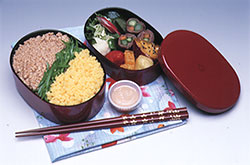 © Web Japan 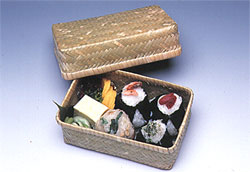 © Web Japan |
|
If you have travelled to Japan before, you may know of (and perhaps even sampled) ekiben. During the Meiji period, railway lines began to snake across Japan, connecting cities to country-sides, and allowing more people to travel much more conveniently throughout the country. Stations starting selling ekiben, or station bento, to cater to the many travellers that passed through their stations each day. While the first ekiben (said to have been sold in 1885 at Utsunomiya Station in Tochigi Prefecture) was a simple meal of rice balls with pickled apricots, now, many stations offer ekiben offering regional delicacies like seafood from Niigata or beef from Sendai. These special ekiben are sometimes packaged in unique boxes that can be taken home as souvenirs once you are done!
Homemade bento are also popular amongst students and the working population as it is cost-efficient, and can be more nutritionally balanced than instant meals from convenience stores and cafeterias. There are many variations of homemade bento, such as the aisai bento, which refers to a lunchbox that is prepared lovingly by a wife for her husband. There is also the shikaeshiben, also known as a “revenge lunch box.” If you have someone at home packing lunches for you, make sure not to draw their ire or stand the risk of receiving a dreaded shikaeshiben! Married couples with children also regularly make bento for their children. Although it is common to make bento with leftover ingredients, some parents make special kyaraben, bento lunchboxes decorated elaborately to replicate people, animals, and even anime characters. Decorated with brightly-coloured ingredients, the visual appeal of kyaraben helps young children enjoy their food more! |
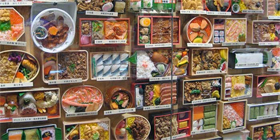 © Web Japan 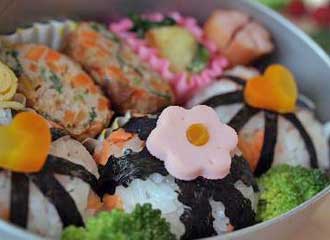 © Muku AR Relations 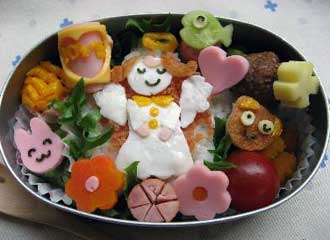 © Muku AR Relations |
|
It goes without saying that carefully made lunchboxes are a way to express feelings of love and appreciation for the receiver. It comes as no surprise then that bento boxes appear in many Japanese manga, anime, and films. Last year, JCC screened the film “Dad’s Lunch Box,” a heart-warming film about a single father who makes bento lunchboxes for his daughter every day throughout her high school years. It was a popular event, and many audience members were able to feel his strong love for his daughter through his daily creations.
During the cherry blossom season, it is common to see groups of people sharing korakuben during viewing parties. These are large bento that contain many small bites, allowing for a close group of family and friends to share a meal together outside under canopies of blooming flowers. |
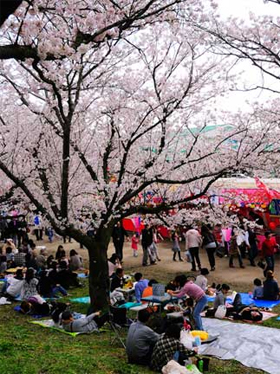 © Web Japan |
|
On Facebook, JCC recently published a series of simple but fun recipes that can be used to fill up your own bento (and help you learn Japanese at the same time)! We have compiled the links altogether below, so feel free to check them out and bookmark them for future reference.
(1) Introduction: https://www.facebook.com/JCCEOJ/posts/2878559045515882?__tn__=-R (2) Onigiri: https://www.facebook.com/JCCEOJ/posts/2880572988647821?__tn__=-R (3) Chikuwa: https://www.facebook.com/JCCEOJ/posts/2882271051811348?__tn__=-R (4) Tamagoyaki: https://www.facebook.com/JCCEOJ/posts/2884426684929118?__tn__=-R (5) Wieners: https://www.facebook.com/JCCEOJ/posts/2886506854721101?__tn__=-R Why not try using these recipes to put together your own delicious bento? |
Resources
|
Ekiben: Excellent Train Ride Eats. Japan-guide.com. (2020). Retrieved 25 March 2020, from https://www.japan-guide.com/ad/ekiben/ |
|
Japan Creative Centre 4 Nassim Road, Singapore 258372 +65 6737 0434 / jcc@sn.mofa.go.jp http://www.sg.emb-japan.go.jp/JCC Nearest parking at Orchard Hotel & Delphi Orchard |
 |